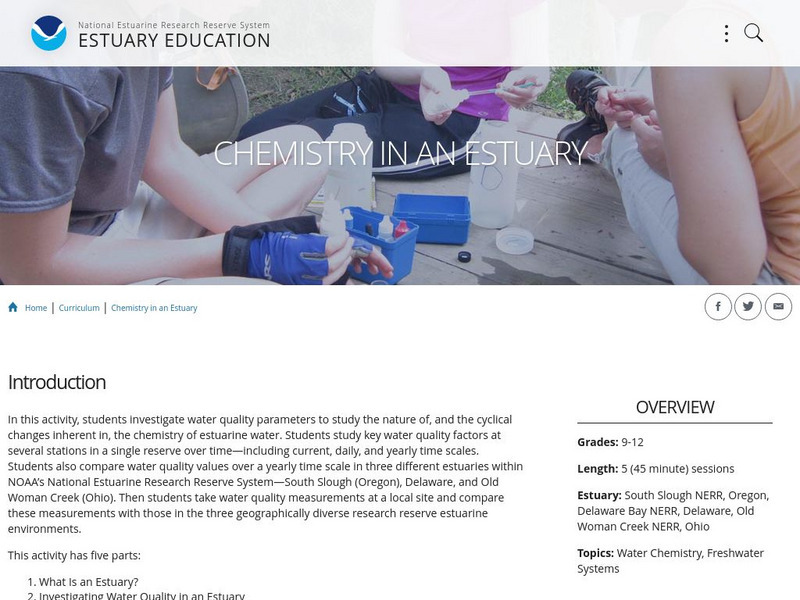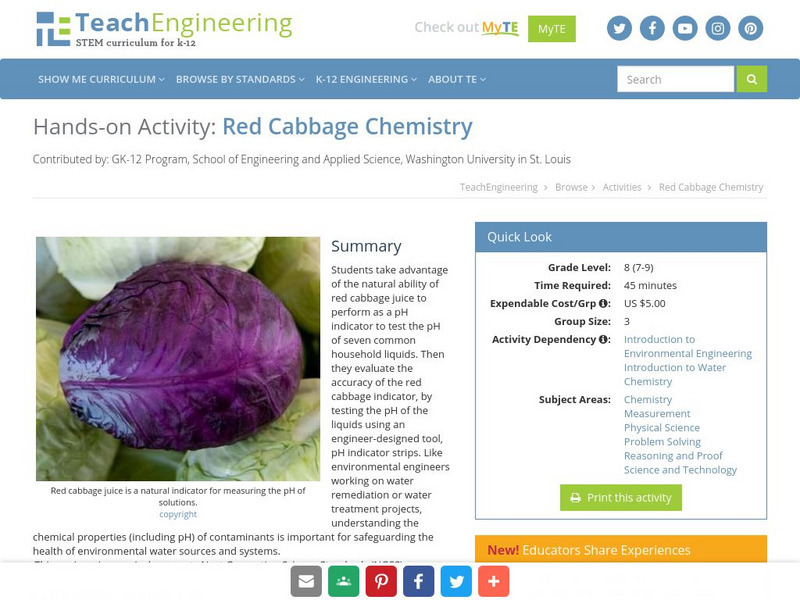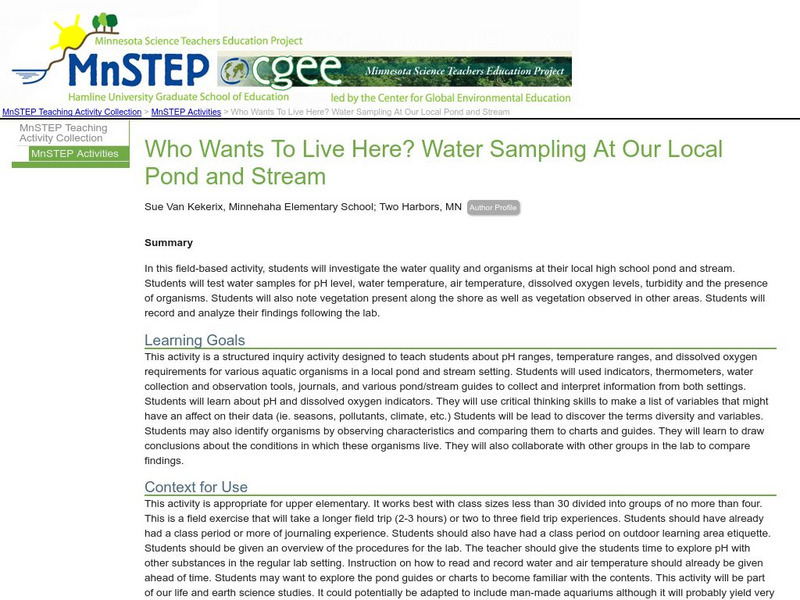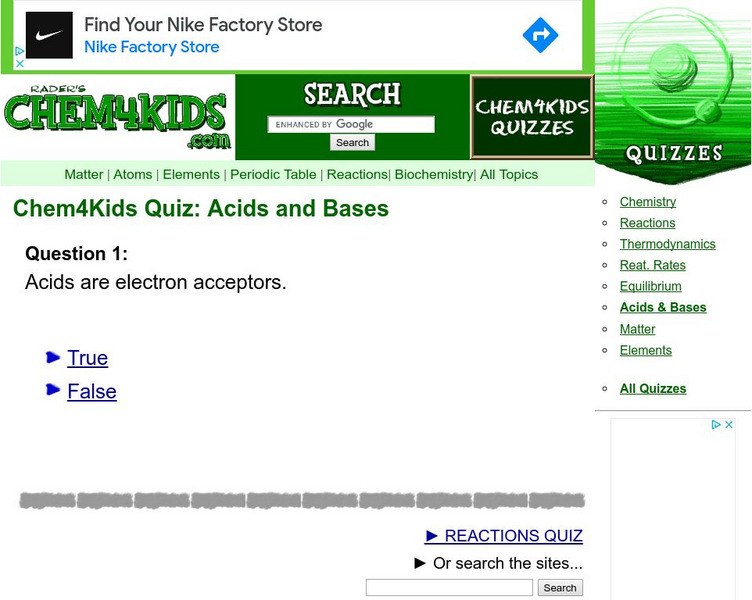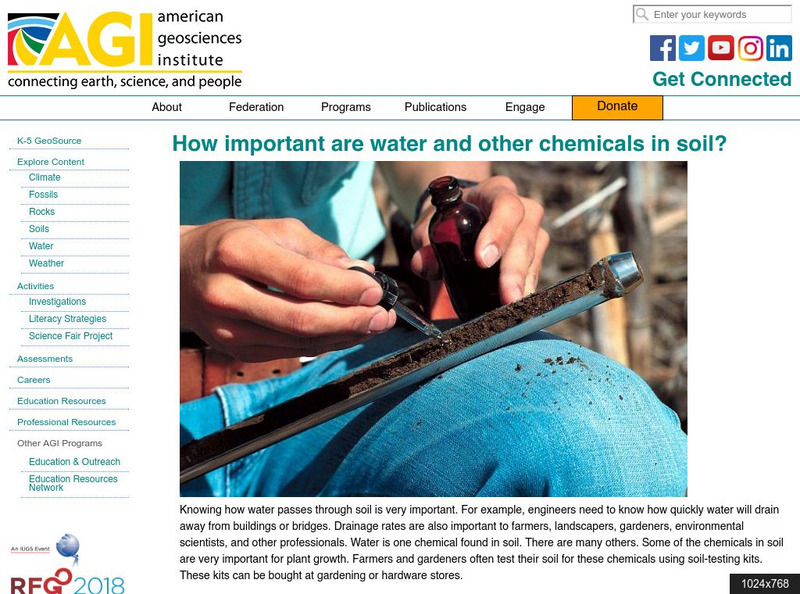Hi, what do you want to do?
Other
Radford University: Environmental History Timeline: Sixties 1960 69
Features an environmental history timeline for the 1960s highlighting legislation and key events. Created by Professor William (Bill) Kovarik, Ph.D. from Radford University.
NOAA
Noaa: Estuaries 101 Curriculum: Chemistry in an Estuary
This activity introduces students to the complex chemistry of estuarine water. Students investigate how chemical and physical water quality factors-pH, temperature, dissolved oxygen, and salinity-change and interact over varying time...
Khan Academy
Khan Academy: How Do Organisms Maintain a Constant P H Range?
Practice questions related to how organisms maintain constant pH range acids.
TeachEngineering
Teach Engineering: Red Cabbage Chemistry
Students take advantage of the natural ability of red cabbage juice to perform as a pH indicator to test the pH of seven common household liquids. Then they evaluate the accuracy of the red cabbage indicator, by testing the pH of the...
Science Education Resource Center at Carleton College
Serc: Mn Step: Who Wants to Live Here? Water Sampling at Local Pond and Stream
The water quality at a local pond or stream is tested, and examined for organisms. Students record their data and observations and analyze the information. A pH chart showing what aquatic organisms can live at different pH levels is...
University of Texas at Austin
College of Natural Sciences: Analysis of Exam After Test
This site gives some examples of things to do after the exam to improve for next time.
University of Arizona
The Biology Project: Acids and Bases Problem Set
How well do you know acids and bases? This interactive resource provides the user with questions and tutorials to provide feedback for those topics you don't understand. Can be used for test review.
Omega Engineering
Technical Dissolved Oxygen: The Fundamentals
This site is useful to find information about dissolved oxygen and the types of tests that are administered to determine the dissolved oxygen level.
Climate Literacy
Clean: Effects of Increased Co2 in the Air on Seawater and Distilled Water
Students perform an experiment comparing the impacts of CO2 on salt water and on fresh water. In a short demonstration, students examine how distilled water and seawater are affected differently by increasing carbon dioxide in the air.
Royal Society of Chemistry
Royal Society of Chemistry: Gridlocks: Level 3
A collection of grid puzzles that cover a wide variety of topics in advanced high school chemistry. These are excellent for topic review and reinforcement. The puzzles can be played online and also downloaded as worksheets. Answers are...
BBC
Bbc: Gcse Bitesize: Types of Chemical Reactions
Bases are substances that can react with acids and neutralize them. Alkalis are bases that are soluble in water. The pH scale measures how acidic or alkaline a substance is. Substances with a pH lower than 7 are acidic, those with a pH...
Other
Environment Canada: What Is Acid Rain?
A thorough explanation of acid rain with a focus on the following topics: what is acid rain, the pH scale measures acidity, what does acid rain do, and what can I do about acid rain.
Other
The Pedosphere and Its Dynamics: Intro to Soil Science
This Pedrosphere site provides a twelve chapter overview of soil science. Numerous topics are discussed and each chapter has a self-test to test your knowledge on the different aspects of soil science. Some chapters are only previews.
BBC
Bbc: Gcse Bitesize: Adaptations Adaptations, Interdependence and Competition
Organisms depend on each other for survival. This is called interdependence. Both living and non-living factors will affect the abundance and distribution of organisms in a habitat. Included is a link to a test.
McGraw Hill
Mc Graw H Ill: Edward S. Kubany, ph.d.
Read a short biography of psychologist Edward S. Kubany, developer of the Trauma-Related Guilt Inventory (TRGI).
Science Education Resource Center at Carleton College
Serc: Disasters to Nature: Sensitivity of Ground Water Systems to Pollution
Students visit three sites to investigate the areas where there is very high sensitivity for ground-water pollution. They also test the quality of water, measuring the dissolved oxygen, pH, total phosphate, nitrates, turbidity, and...
Scholastic
Scholastic: Study Jams! Science: Matter: Acids and Bases
Studying acids and bases? Look no further for an entertaining video to help understand how they work. Check comprehension with the test.
Chem4kids
Chem4 Kids: Quiz: Acids and Bases
A quiz testing your knowledge of acids and bases. Quiz gives immediate feedback on whether your answer was right or wrong with an explanation.
American Geosciences Institute
American Geosciences Institute: Water and Other Chemicals in Soil
Learn why scientists use testing kits to study the soil, and find out what chemicals they test.
TeachEngineering
Teach Engineering: How to Make Yeast Cells Thrive
Students set up and run the experiments they designed in the lesson Population Growth in Yeasts, using simple yeast-molasses cultures in test tubes. Population growth is indicated by the amount of respiration occurring in the cultures,...
Other
Biology Simulations: Enzyme
This simulation can be used to test how factors such as temperature, pH, and concentrations affect the reaction rates of two different enzymes in a biochemical pathway.
Khan Academy
Khan Academy: The Bicarbonate Buffering System and Titration Curves
This is a five-question quiz related to the passage "The Bicarbonate Buffering System and Titration Curves"
Curated OER
Smithsonian Institution Archives: Florence Barbara Seibert (1897 1991)
Biochemist Florence Barbara Seibert (1897-1991) developed the skin test for tuberculosis. After graduating from Goucher College, she worked as a chemist during World War I and then went to Yale University, where she earned a Ph.D. and...
Curated OER
Jean Dougherty Strother With e.j. Ducayet (Right), r.c. Buyers (Left)
Dora Jean Dougherty Strother (b. 1921) (center) was a human factors engineer and test pilot for Bell Helicopter Co. in 1961 when this photograph was taken, and had just broken a helicopter altitude record (at 19,406 feet) in a Bell...






